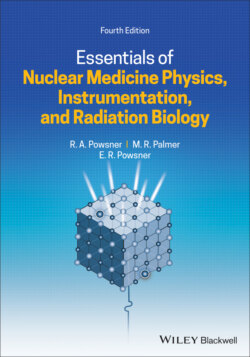Читать книгу Essentials of Nuclear Medicine Physics, Instrumentation, and Radiation Biology - Rachel A. Powsner - Страница 12
CHAPTER 1 Basic Nuclear Medicine Physics Properties and structure of matter
ОглавлениеMatter has several fundamental properties. For our purposes the most important are mass and charge (electric). We recognize mass by the force gravity exerts on a material object (commonly referred to as its weight) and by the object’s inertia, which is the “resistance” we encounter when we attempt to change the position or motion of a material object.
Similarly, we can, at least at times, recognize charge by the direct effect it can have on us, or that we can observe it to have on inanimate objects. For example, we may feel the presence of a strongly charged object when it causes our hair to move or even to stand on end. More often than not, however, we are insensitive to charge. But whether grossly detectable or not, its effects must be considered here because of the role charge plays in the structure of matter.
Charge is generally thought to have been recognized first by the ancient Greeks. They noticed that some kinds of matter, an amber rod for example, can be given an electric charge by rubbing it with a piece of cloth. Their experiments convinced them that there are two kinds of charge: opposite charges, which attract each other, and like charges, which repel. One kind of charge came to be called positive, the other negative. We now know that the negative charge is associated with electrons. The rubbing transferred some of the electrons from the atoms of the matter in the rod to the cloth. In a similar fashion, electrons can be transferred from a cat’s fur to a hand. After petting, the cat will have a net positive charge and the person a net negative charge (Figure 1.1). With these basic properties in mind, we can look at matter in more detail.
Matter is composed of molecules. In any chemically pure material, the molecules are the smallest units that retain the characteristics of the material itself. For example, if a block of salt were to be broken into successively smaller pieces, the smallest fragment with the properties of salt would be a single salt molecule (Figure 1.2). With further fragmentation, the molecule would no longer be salt. Molecules, in turn, are composed of atoms. Most molecules consist of more than one kind of atom—salt, for example, is made up of atoms of chlorine and atoms of sodium. The atoms themselves are composed of smaller particles, the subatomic particles, which are discussed later.
The molecule is held together by the chemical bonds among its atoms. These bonds are formed by the force of electrical attraction between oppositely charged parts of the molecule. This force is often referred to as the Coulomb force after Charles A. de Coulomb, the physicist who characterized it. This is the force involved in chemical reactions such as the combining of hydrogen and oxygen to form water. The electrons of the atom are held by the electrical force between them and the positive nucleus. The nucleus of the atom is held together by another type of force—nuclear force—which is involved in the release of atomic energy. Nuclear forces are magnitudes greater than electrical forces.
